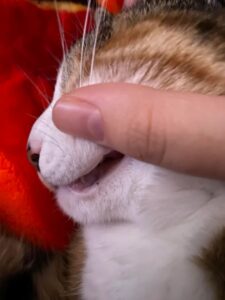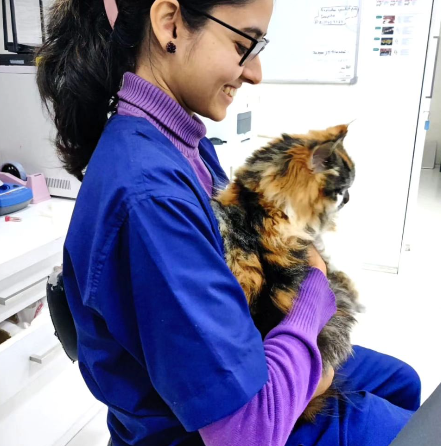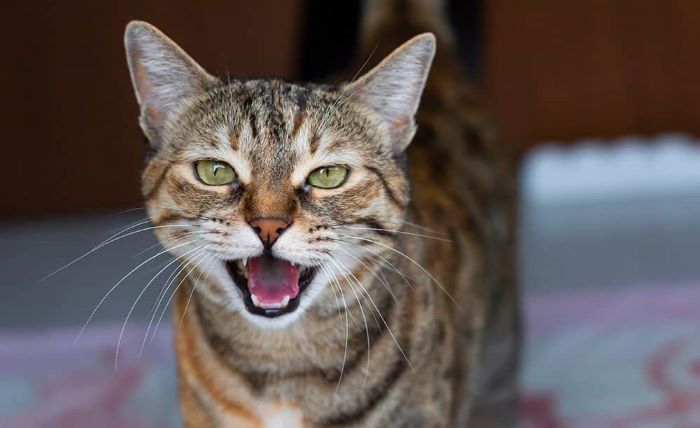Why do cats have black lips? People have been curious about this black stuff for many years. What is even more perplexing about this phenomenon is that there are many different explanations as to why many cats’ lips are black. In this article, we will discuss the most popular theories and their implications on the world of cat lips.
There are a few possibilities for why your cat’s lips are black. One possibility is that the dark pigment helps to protect their lips from the sun’s harmful UV rays. Another theory is that the black coloration helps to keep their lips moist in dry environments.
A third explanation is that the darkness of the lips helps to camouflage them in the wild, making it harder for predators to spot them. And finally, some scientists believe that the black coloring might help attract prey by making the cat’s mouth look like a dark hole.
Regardless of the cause, one thing is clear: a cat’s black lips are one of its most distinctive and identifiable features.
There are several reasons for cats to have black lips and also they have dark spots on the nose and on other parts as well.
As a matter of natural course, cats have black lips. Black-lipped cats include black, orange tabby, and calico cats. Your cat may be suffering from Lentigo in some circumstances. Lentigo is not a form of cancer, it is harmless, same as human freckles.
Don’t be alarmed if your cat’s lips appear to be darker than normal. The majority of the time, your cat’s color is completely healthy and normal.
What Is the Cause of Dark Brims In Some Felines?
Your cat’s lip color is determined by the genes it acquired from its parents. Your cat’s darker lips indicate that it has more melanin in or around its mouth, making them a somewhat unusual hue than other options.
In cats with certain coat hues, black lips appear to be more frequent. Because the black lips are more apparent on an orange cat’s face, they stand out more in orange-furred cats. Gray cats, calico cats, tortoiseshell cats, and a wide range of other colors have all been documented to have totally black lips.
Melanistic Bengal cats, for example, may have been developed in a manner that promotes melanin production, resulting in greater chances of black lips. While black lips are generally fine, unusual changes in your cat’s lip color might be cause for concern.
If your cat’s pink lips turn entirely black, you should visit the doctor. Look for signs of inflammation, decreased hunger, or dehydration, as well as any discharge or strange smells since all of these can be indicators that your cat’s lips are being damaged by a medical problem.
Whether you’re concerned about the color of your cat’s lip, your veterinarian will be able to tell you if you need to make an appointment or if you can watch him at home.
What Is the reason My Cat Lower Lip Is Dark?

The color of your cat’s body pigment varies and changes gradually over time. Most of the time, owners will not notice any changes in their cat’s color or coat pattern until it is too late. As a consequence of this treatment, your cat’s lower lip may darken.
Changes in your cat’s lip over time are not considered a cause for concern by veterinarians. However, if your cat has any other symptoms of illness or displays a significant behavioral change at the same time, it’s something to be concerned about.
A black lower lip is appropriate in most situations. If your cat has a lumpy black color, is producing discharge, or becomes unusually defensive of their face or mouth, they should be seen by a veterinarian.
Is It Unusual For A Cat’s Roof of the Mouth to Be Black
In the case of calico cats, the gums and roofs of their mouths are black. Lentigo, which causes dark spotting that may be quite dense, can also appear on orange cats. Both occurrences are very typical, and they do not indicate anything bad.
However, if your cat’s gums are white, yellowish, blue, or any other hue other than pink or black, this is a red flag. Anemia may be revealed by the presence of white gums.
Bluish gums might indicate that your cat isn’t getting enough oxygen if they’re blue, whereas yellow gums are frequently associated with liver issues. If you notice any of these hues, you should call your veterinarian right away.
What Is Cat Lentigo Disease
The skin, black gums, and even the eyes and nose of cats are afflicted with Skin Mitosis in which tiny black spots form on their skin, and even around the eyes and nose. These black spots, also known as lentigo simplex, don’t have to be worrisome as long as they’re flat and of the same texture as the surrounding skin.
Consider these dots to be feline freckles. Over time, your pet is likely to acquire a few more spots, and they may appear unexpectedly. Some cats have many lentigo stains, whereas others have just a few. Sun exposure, unlike freckles, does not seem to have an influence.
It’s highly probable that your kitten is predisposed to these little markings; it has nothing to do with how attentive you are or the condition of your cat’s environment. You should always have your cat checked by an expert veterinarian.
What Does a Lentigo disease Look Like And Is It Bad In Cats?
Lentonigos are generally easy to detect if they aren’t on the interior of your cat’s mouth. They appear on your cat’s skin, usually round, with small black spots. The dots may be as tiny as a pinhead or a small bead, or they might be as big as a pinhead or a small bead. Spots might develop next to one another in some cases and appear to be far bigger.
Lentigo spots are generally a dark black rather than brown color. Lentigo spots should be flat and of the same texture as the surrounding skin. If your cat’s lentigo patches seem higher, damper, or drier than the surrounding skin, you should visit the vet immediately.
Lentigo is a very typical condition in cats. Lentigo does not affect all cats, but you shouldn’t be too concerned if you have a cat with natural freckles.
Why Does A Cat’s Mouth Look Black
There might be any number of causes for the black material around your cat’s mouth. We advise consulting a veterinarian for an official diagnosis. However, the following are some of the most frequent reasons why.
In rare cases, owners may think that Lentigo is due to an object stuck in their cat’s mouth. The black pigmentation won’t come off or change, which is one of the first telltale signs that your cat has Lentigo. Your cat’s skin may also become inflamed. Because plastic feeding bowls maintain acne-causing bacteria, cats that eat from them are more likely to get acne. Never try random medicines for cat lentigo, because your vet will recommend veterinary medicine for your cat.
Food allergies may occasionally cause a scaly, acne-like rash around your cat’s mouth. Feline acne may also process to reddish, riled that may contain pus. If you have a food allergy in your cat, his veterinarian can most likely recommend an alternative diet or allergy medication.
What Is The Appearance of A Healthy Cat’s Mouth
Your cat’s gums can be pink, black, or any color in between; they should always be plump and wet, with a glint of gloss. The hue should also be consistent; unusual color changes might signal medical problems. Clean cat’s teeth with no visible tartar or little tartar are also required.
Even if your cat’s gums are black or brown, his tongue should be a brilliant pink color and have many barbs. Excessive drooling, tartar accumulation, edema, dryness, or discoloration are all possible signs of illness.
Conclusion
Cats have black lips because they are a sign of aggression. The color is caused by the pigment melanin, which darkens as a cat matures and gets older. This also helps to make their teeth appear larger in comparison to the rest of their body size. Pigmentation is often seen in older cats.
Changes in your cat’s skin and hair color are a normal part of its existence. Any fast change in your cat’s pigmentation, particularly if it is accompanied by additional symptoms, should be investigated seriously.
Cats may also have Vitiligo, which is a similar skin pigmentation condition to Lentigo. Vitiligo is almost the opposite of Lentigo and causes a loss of pigment in areas of the skin. Over time, it’s normal for vitiligo to spread gradually, making your cat’s skin and hair white.
On the other side, Lentigo is generally confined to the skin, so you’ll only notice lentigo spots where your cat’s skin can be seen.
FAQ
Here are some of the most frequently asked questions:
Q. What color should my cat’s lips be?
Ans: The lips of a cat should generally be black, pink, or a combination of the two colors. If your cat’s lips are not one of these colors, it is possible that they have a medical condition that requires treatment.
If you are concerned about the color of your cat’s lips, you should take them to a veterinarian for an examination. The veterinarian will be able to tell you if there is anything wrong and whether or not you need to make an appointment.
Q. Why is my cat’s mouth dark?
Ans: There are a few reasons why your cat’s mouth might be dark. One possibility is that your cat has a medical condition that requires treatment. Another possibility is that your cat has been exposed to the sun for an extended period of time. A third possibility is that your cat has freckles, which are normal and typically don’t require treatment.
Q. What breed of cat has black gums?
Ans: All breeds of cats can have black gums. The color is caused by melanin, which is the same pigment that gives hair and skin their natural color. Melanin production increases as a cat matures, which is why older cats often have darker gums.

Dr. Hansika Singh is a skilled veterinarian with a Doctorate in Veterinary Medicine and over six years of hands-on experience in the field. Her expertise in pet health is complemented by a holistic approach that prioritizes both physical and emotional well-being. Dr. Singh is committed to providing high-quality care and practical advice to ensure pets lead healthy, happy lives.
As the leading expert on everythingpetstuff.com, Dr. Singh shares her extensive knowledge and insights through this platform and her popular social media channels. Follow her for valuable tips and advice on pet care: Instagram, YouTube, and Facebook.

